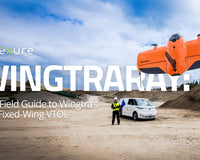1) Key Differentiators

- Comprehensive sensor array in a single payload.
- Compatibility with DJI FlightHub 2 fleet management software.
- Seamless integration with DJI Dock.
- Recent price drop provides added value.

Autel EVO Max 4T:
- Advanced real-time 3D flight path planning.
- No geofencing.
- Proprietary "A-Mesh" system allows for multi-drone control.
- Quick 15-second deployment.
2) Pros and Cons At-a-Glance
DJI Matrice 30T:
Pros: Robust, weatherproof, high-quality integrated cameras, extensive range, great flight time.
Cons: Larger, potentially cumbersome for rapid deployment.
Autel EVO Max 4T:
Pros: Highly portable, advanced object recognition, unique battery swapping system.
Cons: Limited compatibility with third-party software.

3) Flight Time
The DJI Matrice 30T boasts a flight time of 41 minutes, while the Autel EVO Max 4T marginally tops it with 42 minutes. For many professionals, that extra minute might not be a deal-breaker, but every second counts for tasks requiring prolonged aerial surveillance or data collection.
4) Camera Sensors
Both drones have cameras that capture stunning details. The Matrice 30T integrates a 48-megapixel 1/2'' CMOS sensor-zoom camera, offering 5×~16× optical and 200× digital zoom. This contrasts with the EVO Max 4T's 50MP wide-angle and a 1/2 CMOS 48MP zoom camera for 8K 10X zoom. Thermal imaging capabilities are crucial for many industries, and both drones excel here. However, the Matrice 30T slightly edges out with its measurement accuracy of ±2°C or ±2%.
5) Transmission Range
Transmission range is crucial for operators who need to control drones from significant distances. The Matrice 30T's transmission spans between 1.5-15 km depending on interference levels, while the EVO Max 4T advertises up to 12.4 miles.
5) Controllers, Accessories, and Other Features
The Matrice 30T is controlled using the advanced DJI RC Plus Remote, benefiting from the DJI Pilot 2 software that enhances the flight experience. In contrast, EVO Max 4T utilizes Autel's Smart Controller while offering key features such as a hot-swappable battery system and AI Recognition to reduce cognitive workloads for pilots.

Industry Use Cases
Both drones serve a multitude of industries:
- Law Enforcement: Advanced cameras aid in surveillance and crowd control.
- Firefighting: Thermal imaging can detect hotspot areas.
- Search and Rescue: Object recognition helps locate missing individuals.
- Inspections: High-resolution cameras provide detailed imagery of infrastructure.
- Mapping/Surveying: Stable flight patterns and high-quality sensors ensure accurate data capture.
- Forestry: Monitoring vast forested areas becomes more manageable.
- Construction: Provides bird's-eye views of ongoing projects.
The choice between the Matrice 30T and EVO Max 4T hinges on specific requirements in these sectors. For rapid deployment and portability, EVO Max 4T might be favored. But for more robust missions, the Matrice 30T could be the preferred choice.
Our Verdict
Though a tight race, given the recent price drop, the Matrice 30T takes the crown. Users get a larger platform for nearly the same price. The EVO Max 4T's primary advantages are its absence of geo-fencing and its more compact form factor. However, overall versatility and performance make the Matrice 30T our top recommendation.Still deciding?
Drones are an investment, and choices should be made after careful consideration. If you're grappling with decisions or need expert insights, don't hesitate. Reach out to Advexure's team of subject matter experts - including part 107 pilots, former public safety servants, and industry connoisseurs. Get all your questions and request a quote here.










